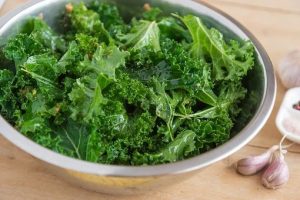Written by Chrystal Moulton, Staff Writer. Individuals in the highest quintile of nitrate intake had a 62% lower risk of developing open-angle glaucoma (p= 0.002).
 Studies on alternative treatments and prevention of glaucoma have demonstrated potential benefits in consumption of dark green leafy vegetables1,2. These benefits may be linked to the amount of nitrate naturally found in green leafy vegetables3,4. Intraocular pressure, commonly associated with glaucoma, is affected by nitric oxide1 and the progression of open angle glaucoma is associated with reduced bioavailability of nitric oxide5. In the current study, researchers investigated the association between dietary nitrate intake, open-angle glaucoma (OAG), and intraocular pressure (IOP)6.
Studies on alternative treatments and prevention of glaucoma have demonstrated potential benefits in consumption of dark green leafy vegetables1,2. These benefits may be linked to the amount of nitrate naturally found in green leafy vegetables3,4. Intraocular pressure, commonly associated with glaucoma, is affected by nitric oxide1 and the progression of open angle glaucoma is associated with reduced bioavailability of nitric oxide5. In the current study, researchers investigated the association between dietary nitrate intake, open-angle glaucoma (OAG), and intraocular pressure (IOP)6.
Data for this trial came from the Rotterdam Study, a prospective study assessing the determinants of age-related diseases in adults 45 years and older7. Ophthalmic examinations were conducted during the Rotterdam study. Among the participants who consented to ophthalmic examinations, only 7,008 had baseline dietary nitrate intake data. Of the 7008, 173 participants developed OAP. Based on this information, researchers in this trial conducted a case-control study matching cases and controls by age and sex in a 1:5 ratio (173 cases to 865 controls). Dietary intake of nitrate was assessed through food frequency questionnaires. Additional demographic, medical, and anthropometric data was also collected from all participants. Participants were categorized into 5 groups based on nitrate intake.
In a multivariable adjusted model, researchers found a negative correlation between nitrate intake and risk of open-angle glaucoma. Specifically, every 10mg/day increase in nitrate intake was associated with 5% decrease in the risk of developing OAP. Compared to participants in the lowest quintile (Q1- mean 48.8mg/day total dietary nitrate), individuals in the highest quintile (Q5-mean 213.0mg/day total dietary nitrate) had a 62% lower risk of developing open-angle glaucoma (OR= 0.38, p= 0.002). Further analysis showed that, nitrate from vegetable sources was significantly associated with reduced risk of OAP (p= 0.003) while nitrate from non-vegetable sources showed no significant association with open-angle glaucoma (p= 0.08). No significant association was found between intraocular pressure and total dietary nitrate. No significant association was found between dietary nitrate and blood pressure. Demographic data showed that participants with higher intake of nitrate were more educated than those in the lowest quintile. Furthermore, individuals in the higher quintile of nitrate intake had higher scores on quality of diet, total energy consumption, and BMI compared to those in the lowest quintile.
Overall, nitrate intake was significantly associated with a reduced risk of open-angle glaucoma in a dose-dependent manner. No significant association was found between intraocular pressure and nitrate intake. Study limitations include the limited possibility of detecting statistically significant IOP-lowering effects of dietary nitrate intake based on the lack of OAG cases having exorbitant IOP measurements typically associated with OAG, along with the potential for subjects to misclassify the amount of nitrate consumed based on possible recall bias in FFQ results. Additional studies will be needed to verify the results of this study.
Source: Vergroesen, Joëlle E., Tosca OE de Crom, Lauren C. Blekkenhorst, Caroline CW Klaver, Trudy Voortman, and Wishal D. Ramdas. “Dietary Nitrate Intake Is Associated with Decreased Incidence of Open-Angle Glaucoma: The Rotterdam Study.” Nutrients 14, no. 12 (2022): 2490.
© 2022 by the authors. Licensee MDPI, Basel, Switzerland. This article is an open access article distributed under the terms and conditions of the Creative Commons Attribution (CC BY) license (https://creativecommons.org/licenses/by/4.0/).
Click here to read the full text study.
Posted August 4, 2022.
Chrystal Moulton BA, PMP, is a 2008 graduate of the University of Illinois at Chicago. She graduated with a bachelor’s in psychology with a focus on premedical studies and is a licensed project manager. She currently resides in Indianapolis, IN.
References:
- Kang JH, Willett WC, Rosner BA, Buys E, Wiggs JL, Pasquale LR. Association of Dietary Nitrate Intake With Primary Open-Angle Glaucoma: A Prospective Analysis From the Nurses’ Health Study and Health Professionals Follow-up Study. JAMA Ophthalmol. Mar 2016;134(3):294-303. doi:10.1001/jamaophthalmol.2015.5601
- Giaconi JA, Yu F, Stone KL, et al. The association of consumption of fruits/vegetables with decreased risk of glaucoma among older African-American women in the study of osteoporotic fractures. Am J Ophthalmol. Oct 2012;154(4):635-44. doi:10.1016/j.ajo.2012.03.048
- Sweazea KL, Johnston CS, Miller B, Gumpricht E. Nitrate-Rich Fruit and Vegetable Supplement Reduces Blood Pressure in Normotensive Healthy Young Males without Significantly Altering Flow-Mediated Vasodilation: A Randomized, Double-Blinded, Controlled Trial. J Nutr Metab. 2018;2018:1729653. doi:10.1155/2018/1729653
- Brkić D, Bošnir J, Bevardi M, et al. NITRATE IN LEAFY GREEN VEGETABLES AND ESTIMATED INTAKE. African journal of traditional, complementary, and alternative medicines : AJTCAM. 2017;14(3):31-41. doi:10.21010/ajtcam.v14i3.4
- Doganay S, Evereklioglu C, Turkoz Y, Er H. Decreased nitric oxide production in primary open-angle glaucoma. Eur J Ophthalmol. Jan-Feb 2002;12(1):44-8. doi:10.1177/112067210201200109
- Vergroesen JE, de Crom TOE, Blekkenhorst LC, Klaver CCW, Voortman T, Ramdas WD. Dietary Nitrate Intake Is Associated with Decreased Incidence of Open-Angle Glaucoma: The Rotterdam Study. Nutrients. Jun 15 2022;14(12)doi:10.3390/nu14122490
- Ikram MA, Brusselle GGO, Murad SD, et al. The Rotterdam Study: 2018 update on objectives, design and main results. Eur J Epidemiol. Sep 2017;32(9):807-850. doi:10.1007/s10654-017-0321-4
